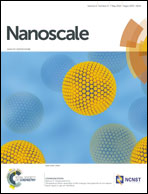Bandgap engineering and manipulating electronic and optical properties of ZnO nanowires by uniaxial strain†
Abstract
Bandgap engineering is a common practice for tuning semiconductors for desired physical properties. Although possible strain effects in semiconductors have been investigated for over a half-century, a profound understanding of their influence on energy bands, especially for large elastic strain remains unclear. In this study, a systematic investigation of the transport properties of n-type [0001] ZnO nanowires was performed at room temperature using the in situ scanning tunnelling microscope-transmission electron microscope technique which shows that the transport properties vary with the applied external uniaxial strain. It has been found that the resistance of ZnO nanowires decreases continuously with increasing compressive strain, but increases under increased tensile strain, suggesting piezo-resistive characteristics. A series of near-band-edge emissions were measured and the corresponding variations of bandgaps were obtained during the application of tensile strain of individual ZnO nanowires via cathodoluminescence spectroscopy. From this, a relationship between the changes of energy bandgap and the transport properties, both induced by uniaxial strain, is built.


 Please wait while we load your content...
Please wait while we load your content...